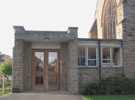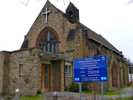For this church:    |
|
| 6 March 1903 | License to hold Divine Service in the building known as Chilwell Mission Church situate in the Parish of Attenborough with Bramcote, the property of Frederic Chatfield Smith, Esq, for the convenience of the inhabitants residing at a distance from the churches of Attenborough and Bramcote. |
We know nothing more. There is no record of the opening in Nottingham newspapers (eg Nottingham Daily Express), and the Beeston local paper began only in 1910. The first register is a Christening Register dating from 1903. Since the new mission church was still subject to Attenborough for ecclesiastical purposes there is a note inside the cover of the Baptism Register to the effect that ‘All entries of Baptism made in this Register have also been entered in the Register of Baptism kept in the Parish Church of Attenborough’. It was subsequently noted that ‘The provision ceases to be necessary upon the Consecration of the Church and as from 1st January 1928 this practice is discontinued’.
The first baptism was on 5th April 1903 when Nina Stevens of Chilwell was christened. She was the daughter of Everett and Sarah Ann Stevens, who lived on Park Road and, reflecting the nature of work in the area, her father a lace designer. Baptisms were taken by the vicar of Attenborough, the Rev Arthur E Hughes.
From 1903 until 1915 Christ Church functioned as a Mission Chapel with services conducted by the Vicar of Attenborough.
In April 1914, one of the trustees of the church, E Kyrle Smith, wrote to the Secretary of the Ecclesiastical Commissioners to say that:
About 10 years ago my father the late Mr F.C. Smith built a church at Chilwell in this county which up to the present has been used as a mission church in connection with the parishes of Attenborough and Bramcote. There is now a separate curate to take the services at Chilwell and the Trustees wish to have the church consecrated. Will you please let me know the order of procedure.
In response, the Commissioners noted that the fabric would have to be conveyed to them before a consecration could take place, a deed of transfer would be needed, and an architect appointed by the commissioners would have to inspect the building. All this seemed to take a long time, and the Vicar of Attenborough and Bramcote, Arthur E Hughes, wrote again on 17th February 1915. Following a noncommittal reply he wrote yet again on 19th March 1915 asking them to speed up the process because he wanted to arrange for the consecration to take place.
The deed of conveyance was completed on 1st June 1915 from the trustees to the Ecclesiastical Commissioners, and the church was consecrated on 3rd July 1915 by the Bishop of Southwell, Dr Edwyn Hoskyns, who received the Deed of Conveyance from Mr Kyrle Smith, representing the former owner, the late Mr FC Smith. In his sermon Bishop Hoskyns paid tribute to the late Mr Smith who, he said, had seen the needs of that part of the parish of Attenborough, and generously provided a place of worship.
Because of the consecration in 1915, Christ Church is often reckoned to date from then. Thus the church celebrated its Diamond Jubilee on 3rd July 1975.
From 1914 until June 1919 baptisms were taken by the Rev Sidney Charles Belcher, who was curate-in-charge under Attenborough. Belcher seems to have left in June 1919, and then there are one or two baptisms by William Brown, vicar (presumably in the absence of a curate at Chilwell). From January 1920 until July 1926 the baptisms are mainly by the Rev FW Walker, curate, and from March 1927 until September 1928 by the Rev Edward Dunnicliffe. In 1929 they were taken by the Rev JB Fraser, vicar from 1923, but in 1934 by the Rev S Oddie, priest in charge. In 1930 the church reputedly had 150 seats, and a Sunday School of fifty pupils.
Christ Church provided seating for 192 people, and there was probably little need for more before World War II. In 1920 Chilwell was described in the following terms:
This parish lies to the South of Bramcote and to the W. of Beeston. The populated portion of the parish is practically a continuation of Beeston. The principal industry is lace manufacture of which there are several firms. A large part of the parish is agricultural, and on the western boundary is the Chilwell Factory, established during the War as a shell filling factory and now used as the Royal Army Ordnance Depot. This extends across the Boundary, the greater portion being in the adjoining parish of Toton, and the smaller portion only in Chilwell. In the Southern corner of the Parish is the village of Attenborough….
The Vicar of Bramcote proposed to the Ecclesiastical Commissioners in January 1927 that a church hall might be built on land surrounding the church, but the commissioners responded that they believed it was more important to have a house for the clergyman than a separate hall.
With the sale of Chilwell Hall, and the subsequent building of new housing in the area of north Chilwell towards Bramcote, quite apart from the subsequent development of Field Lane, the parish grew rapidly. The arrival of Ericsson in Beeston, and the expansion of the Boots site, greatly increased demand for housing in the area.
By the mid-1950s Christ Church served a population of 14,000, and plans were drawn up for adding a chancel to the church. The vicar, the Rev RT Warburton, reckoned that there was currently seating for 240 in the church, but with a chancel it would be possible to raise the total to 370. The anticipated cost was £5,800. The chancel was built under the direction of Architect Vernon Royle, although the cost rose before completion in 1957 and Warburton struggled to find the funds.
In the early 1960s choir vestries were built along the north leaving light wells into the church and linked into the vestry.
 West
extension West
extension |
In 1980 a flat roof single storey extension was added to provide an additional 60 seats and a new entrance at the west end of the Church adjacent to College Road.
In 1988, as a result of a bequest the existing Vestry was doubled in size to provide more space to enable the signing of the wedding register as well as privacy for interviews.
Towards the middle of the 1990s discussions took place to see how a Parish Office could be accommodated with the Church and how best the Church could respond to the Disability Discrimination Act by providing suitable access to toilets and other facilities. A new extension was designed by Building Design Partnership and provided a new entrance, office, toilets, a prayer room and two meeting rooms, one utilising part of the roof space. It was opened in 1998.
In 2006 the old flower cupboard was adapted into a new servery to dispense drinks and provide a welcoming area at the back of the Church.
In 2009, prompted by issues of access with fixed pews and a narrow aisle and the discovery of dry rot within some of the flooring, the maple flooring was replaced by a new oak flooring covering the Nave and the extension and new flexible seating was provided throughout.
Although Chilwell had no Anglican church until the twentieth century, Methodism reached the village much earlier. A Mr T Allin and a Mr Thomas Harrison of Stapleford introduced Methodism in 1795-6. The house of a framework knitter was registered as a dissenting meeting house on 22nd September 1796. The Chilwell Methodists broke away to become Kilhamites in 1798, and registered as their meeting house a cotton mill belonging to John Salmon. In 1857 the Charlton family, lords of the manor, gave a site for a Methodist chapel on Clarke’s Lane, and this was enlarged in 1878. The modern chapel dates from 1973.






